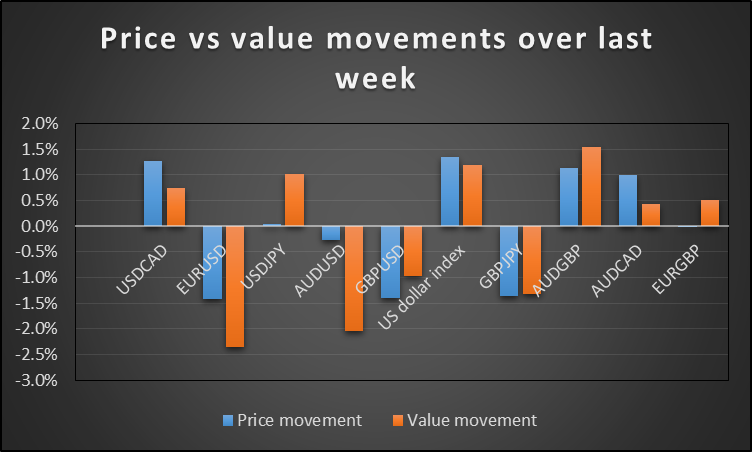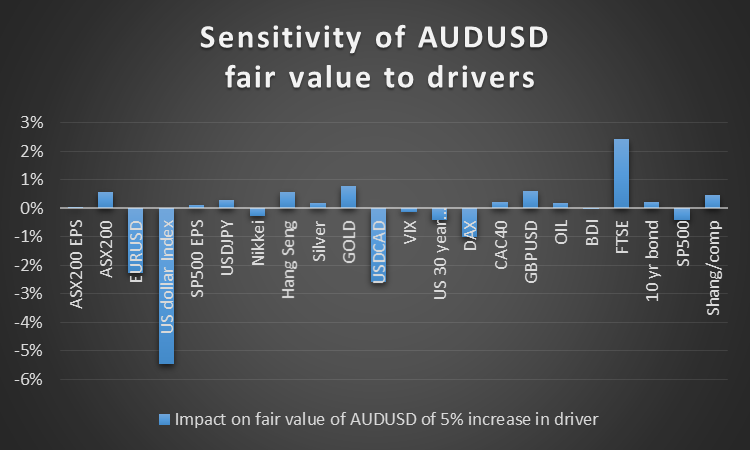Our fair value monitor shows that over the last week, the main divergence between fair value movement and actual price movement occurred for the AUD/USD, with lesser divergences for USD/JPY and EUR/USD. AUD/USD weakened 0.3% while its fair value declined by 2.0%, to become 1.8% more expensive on a relative basis. This would indicate a short term sell/shorting opportunity.

AUD/USD is negatively correlated to the US dollar index, USD/CAD and the VIX, each of which increased over the week. It is positively correlated to the FTSE, which declined over the week. On balance these factors should have pulled AUD/USD down significantly, as can be seen below.

Our backtesting shows that over the last 90 days, trading AUD/USD as dictated by the divergence between the previous week’s fair value movement and price movement would have resulted in a 22.5% annualized gain with 9.7% annualized volatility. (Better results can be achieved by trading a portfolio of currency pairs using the divergence indicator and better still by including major stock indices and commodities.)
What to watch for:
The divergence between price and fair value movement would be eliminated if AUD/USD falls to 0.7955, assuming no movement in fair value. However the fair value itself will move, depending on the movement in its drivers. The sensitivities are shown in the graph below.

A short AUD/USD trade will benefit from further increases in the US dollar Index and VIX. Any strength in EUR/USD and USD/CAD will also assist. The main stock index to watch is the FTSE, strength in which will support AUD/USD to the detriment of the short trade.
What supports the discussion?
At www.fairvalueonline .com we make fair value estimates for 27 series using multiple regression analyses of 6.5 years of daily price data. The series are:
Tradeable securities
Stock indices:
DAX, CAC40, FTSE, SP500, Shanghai Composite, Hang Seng, Nikkei, ASX 200
USD currencies:
USD/JPY, GBP/USD, AUD/USD, EUR/USD, USD/CAD
Cross currencies:
AUD/GBP, AUD/CAD, GBP/JPY, EUR/GBP
Commodities:
Oil (Brent, crude), Silver, Gold
Other driver variables used in the regressions:
VIX, SP500 earnings per share, ASX 200 earnings per share, US Dollar Index, US 30-Year bond rate, Australian 10-Year bond rate, Baltic Dry Index.
For all the series excluding the cross currencies, 23 regressions are run with the other 22 series being independent (driver) variables. The goodness of fit is very high with “R-squared” typically above 95%. The regressions are rerun weekly with a rolling dataset kept at 6.5 years (the earliest week is dropped off as the latest is added).
For the cross currencies, the series applying to each currency is regressed against 22 of the other series (excluding the other cross currencies).
Each day, the previous day’s closing prices are input into the equations to give an updated fair value estimate for each of the 27 variables. A percentage under/over valuation is calculated by relating the latest prices to the updated fair value estimates (to show as undervaluation if latest price is less than fair value and over valuation if conversely).
Also shown is the price/fair value ratio applying now minus that applying five trading days previously. This gives an indication of whether the security has become relatively more expensive (increase in price/value ratio) or relatively cheaper (decrease in price/value ratio) over the last five trading days. The above discussion reflects use of this indicator in that AUD/USD has become relatively more expensive over the last week.
